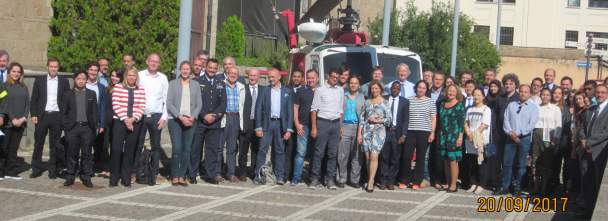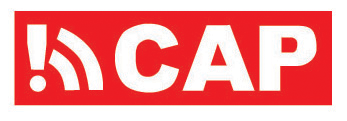
The report of the 2017 CAP Implementation Workshop has been published on the Global Disaster Preparedness Center website.
The Common Alerting Protocol

CAP (Common Alerting Protocol) is a communication protocol for exchanging public warnings between alerting authorities (and public). CAP is used globally by organisations that deals with emergency management, meteorology and public alerting. It is designed for “all-hazards”, related to weather events, earthquakes, tsunami, volcanoes, public health, power outages, and many other emergencies. CAP is also designed for “all-media”, including communications media ranging from sirens to cell phones, faxes, radio, television, and various digital communication networks based on the Internet. Agencies related to WMO (World Meteorological Organization) use CAP as their standard for communication.
The CAP format is compatible with emerging techniques, such as Web services, as well as existing formats including the Specific Area Message Encoding (SAME) used for NOAA Weather Radio and the Emergency Alert System, while offering enhanced capabilities that include:
- Flexible geographic targeting using latitude/longitude shapes and other geospatial representations in three dimensions;
- Multilingual and multi-audience messaging
- Phased and delayed effective times and expirations
- Enhanced message update and cancellation features
- Template support for framing complete and effective warning messages
- Facility for digital encryption and signature capability
- Facility for digital images and audio
In Italy, CAP has been adopted as the official protocol for information exchange by the Department of Firefighters, Public Rescue and Civil Defence (Ministry of the Interior) with two Ministerial Decrees in 2008 and 2011. By doing so, it has been stated that CAP is the only protocol that any emergency organisation that communicate with the Department of Firefighters must use.
CAP is the protocol on which the JIXEL family is based.
The participants
The Workshop was hosted by the Italian National Fire Corps and co-sponsored by the International Association of Emergency Managers (IAEM), the International Federation of Red Cross and Red Crescent Societies (IFRC), the International Telecommunication Union (ITU), the OASIS standards organization, and the World Meteorological Organization (WMO). There were 72 experts from 20 countries.
The presentations
The workshop saw speakers from:
- Italy (National Fire Corps, Civil Protection)
- Germany (DWD – German Weather Service, DLR – German Aerospace Center)
- China (National Early Warning Center)
- Zimbabwe (Meteorological Services Department of Zimbabwe)
- Norway (Met Norway)
- AccuWeather
- ITU (International Telecommunication Union)
- Philippines (Philippine Atmospheric Geophysical and Astronomical Services Administration – PAGASA)
- WMO – World Meteorological Organization
- Amazon (Cloud Services)
- International Federation of Red Cross and Red Crescent Societies (IFRC)
- France (Météo France)
- Iran (Iran Water Resources Management Company)
- Sahana Software Foundation
- OASIS (Organization for the Advancement of Structured Information Standards)
A presentation regarding Mexico was cancelled due to the devastating earthquake that hit Mexico on 19 September.
CAP-based Alerting System via Commercial Radio
The presentation is available here: http://www.preparecenter.org/sites/default/files/cap-workshop-2017-commercial-radio.pdf
WMO Global Multi-hazard Alert System (GMAS)
Miriam Andrioli (WMO), in collaboration with Armstrong Cheng of Hong Kong Observatory, presented the WMO Global Multi-hazard Alert System (GMAS), and showed the progresses on leveraging the World Weather Information Service (WWIS) and the Severe Weather Information Centre (SWIC) as platforms to disseminate weather warnings in CAP format. The presentation also explained how the WMO Alert Hub (see http://alert-hub.org) prototype could be integrated into GMAS. Miriam noted that HKO plans to Upgrade SWIC to become an online GIS-enable platform that aggregates, displays and shares authoritative warnings and alerts in CAP format, and to enhance WWIS to become a online GIS-enable platform for official weather observations, authoritative forecasts and warnings provided by NMHSs around the world.
The presentation is available here: http://www.preparecenter.org/resources/cap-workshop-2017-wmo-gmas
IFRC ‘What Now’ Service in Collaboration with Google
Omar Abou-Samra gave a presentation on the new ‘What Now’ service being developed by the International Federation of Red Cross and Red Crescent Societies (IFRC) in partnership with Google. He explained that the service is a data feed of actionable and contextualized messages on how to prepare and respond to local hazards, designed specifically to complement CAP messages. For example, he showed these ‘What Now’ messages for a Typhoon Alert:
1. Prepare to evacuate, and know when and where to evacuate
2. Turn off utilities and gas tanks. Unplug small appliances
3. Never try to drive through flood waters. Turn around and go the other way
Omar said that the messages are based on IFRC Public Awareness and Public Education messaging – a compilation of evidence-based, concise, actionable information for disaster risk reduction that is customizable to fit local hazards, culture, and context. He also noted that the target audiences of the service are individuals and households; the service intends to cover 20 hazards, 6 urgency levels; and 78 languages; and the service should eventually be available in 192+ countries. He said the “What Now” service is available in API form for any network platform utilizing CAP and public alerts.
The presentation is available here: http://www.preparecenter.org/resources/cap-workshop-2017-whatnow
2018 edition
The 2018 CAP Implementation Workshop will be hosted by Hong Kong Observatory, in Hong Kong, about a year from now.
2019 edition
There are already two proposals for the 2019 edition: Geneve (Switzerland) and Whitehorse (Yukon, Canada).
More info
The report (in pdf) is available at this link: http://www.preparecenter.org/sites/default/files/cap-workshop-2017-report_3.pdf . It includes the links to all the presentations held during the Workshop.



